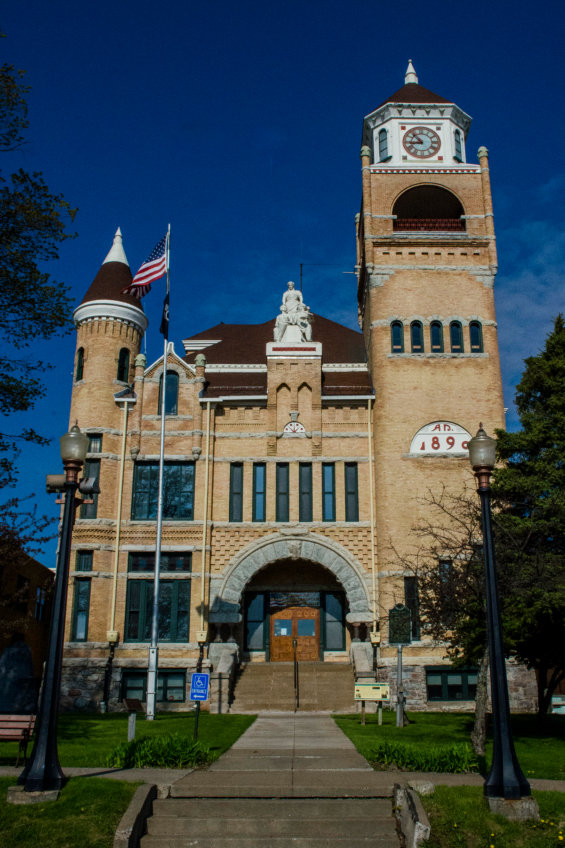
IRON COUNTY
Courthouse
The Iron County Courthouse in Crystal Falls, Michigan, an imposing castle-like structure built in 1890 stands at the head of Superior Avenue commanding a view of the main street of the City and the scenic panorama of the valley at its feet. On a clear day one can stand on the tower balcony and see neighboring Iron Mountain across the hills some 20 miles away. The brick structure, described as “to the Queen’s taste” and “the finest building Northwest of Milwaukee or Detroit” in 1891, was named to the National Register of Historic Places in February 1975 – the first such site to be named in the Iron County area.
The Stealing of the Iron County Courthouse
While the Iron County Courthouse is now a national landmark, many people will recall the lore which surrounds it and bold political larceny assigned to its origins. When the state legislature set off Iron County from Marquette County in 1885, the City of Iron River, Michigan, was designated temporary county seat. A permanent site was to be chosen later by election. Neighboring Crystal Falls, older but by a few months and more densely populated, cherished the title of county seat.
The “Stealing of the Courthouse” has been the topic of many a conversation and article. It is somewhat difficult to separate the fact from fiction. Most versions of the story agree that a poker game was arranged to follow a board of supervisors meeting in the temporary courthouse. The game was at its height at the Old Boyington Hotel. Two Crystal Falls, men, Frank Scadden and Bert Hughitt, left the game pretending to go upstairs to bed. Instead, the sneaked out and back to the temporary courthouse. Treasurer Hughitt cleared the safe of all county records, loaded them on a sled and took them to the railyard where they were loaded into a boxcar. The two men took the records to Stager, the oldest station in the County, and then they were put into safe keeping – some say in hollow pine trees, other in the Mastodon Mine.
The election was held in 1888. Again, stories about importing lumberjacks for the election, destroying ballots of opposing votes, and registering votes from the cemeteries are accorded to both communities. Crystal Falls won the election by a scant margin of five votes.
However, on February 28, 1889, a resolution was adopted to remove the County seat to Iron River and that matter placed before the electors at the ensuing spring elections. Election results showed a total of 2,193 votes cast on the issue with 1,050 favoring removal and 1,142 being against the proposed change. This appears to have settled the controversy, and as the stipulation exacted by the taxpayers vote at the launching of the County, that no courthouse be constructed for a period of five years, was not nearing fulfillment, the more public spirited leaders turned their energies in this direction.
A committee recommended the raising of $30,000 for the purpose and that the proposition be placed before the electors at the forthcoming annual Township elections. The bond issue was approved by a vote of 1,164 to 567, and on April 22, the Board proceeded with the steps necessary to carry out the mandate.
J.C. Clancy, an architect of national reputation, designed the building, characteristic of the Romanesque revival period with its high-pitched roof, high windows, deeply arched doorways, and exterior ornamentation. The contractor for the building was Louis A. Webber, whose low bid of $26,470 was accepted by the County Board. However, Webber had some problems in completing his contract due to personal illness and the County Board was forced to call in another contractor to finish the work. The total cost rose to about $40,000.
Work on the building started in July 1890. By November the walls were erected as high as the ceiling on the second story and part of the roof was on. In February 1891, plastering and the installing of black oak were in progress. By May the tower was near completion and the 17-foot high statues of Law, Mercy, and Justice were placed in position.
The clock in the tower was not added until some time later, the funds being by public subscription. It was wound weekly by a succession of local jewelers. The clock, made by one of the finest clock companies in the United State, the Howard Company, has four faces, and according to one jeweler, one of the biggest problems is keeping the hands on all sides synchronized. In the early days, before electrification, the weights, wound by a windlass, took fifteen to twenty minutes to wind. The largest weight for the strider weighs about a half-ton. Beneath the clock on a balcony is a huge bell, which on a clear day could be heard over four miles away. The hammer, which strikes the bell, weighs over fifty pounds. The bell is hung on eight by eight timbers that were replaced in 1974. During World War II, the balcony was used for air watches by the Civilian Defense. The clock bell is no longer allowed to ring as the vibration causes damage to the deteriorating tower and building.
